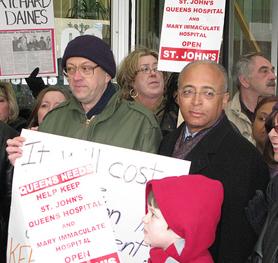— Charges that State has no plan; patients may suffer–
New York City Comptroller William C. Thompson, Jr. today called on the New York State Department of Health (SDOH) to reconsider or delay the closures of Mary Immaculate and St. John’s Queens hospitals planned for the end of the month.
In a letter to Commissioner Richard Daines, Thompson wrote: “SDOH has not publicly disclosed its plans to address the consequences of these closures. SDOH has also failed to address concerns including how nearby emergency rooms such as the one at Jamaica Hospital will be able to absorb an expected 50 percent increase in demand.”
Thompson charged that the SDOH made little effort to engage the community and stakeholders in its closure plans, despite knowing that the hospitals were in financial trouble.
“With the City’s economy in decline, these closures are poorly timed from both a health care and economic perspective,” Thompson continued. “As increasing numbers of City residents lose their jobs and health insurance, there will be significant demands on emergency rooms as City residents’ access to primary care decreases. With capacity already strained, crowded emergency rooms mean longer wait times for patients, delayed ambulance response times, and possibly, diminished health outcomes.”
Thompson also expressed concerns regarding patient notifications and coordination with providers to ensure the continuity of care for out-patients. He also questioned how remaining hospitals will absorb the financial impact of increased patient loads.
Thompson called on the SDOH to reconsider or delay the closures of the facilities until the concerns he raised are addressed.
Over the last month, Thompson has been advocating to prevent the closures of the hospitals and previously called on the State to find a solution that would be equitable for the residents and hospital employees.
In 2006, Thompson issued a report “Emergency Room Care: Will It Be There?,” analyzing the impact of the proposed closure of five hospitals, including Parkway Hospital in Queens. The report detailed how such closures could overwhelm emergency rooms at neighboring hospitals, reduce ambulance availability, and require New Yorkers to travel farther to reach an emergency room. Since then, Parkway Hospital, which was located near Mary Immaculate Hospital in Forest Hills has closed, placing added pressure on the remaining hospitals. If Mary Immaculate and St. John’s close as well, Western and Southwestern Queens will have lost 3 hospitals within two years.
In 2004, Jamaica Hospital, the closest hospital to Mary Immaculate, had roughly 100,000 emergency room visits compared to approximately 45,000 at Mary Immaculate. If all of the patients from Mary Immaculate switched to Jamaica Hospital, this would represent an almost 50% increase in activity.



